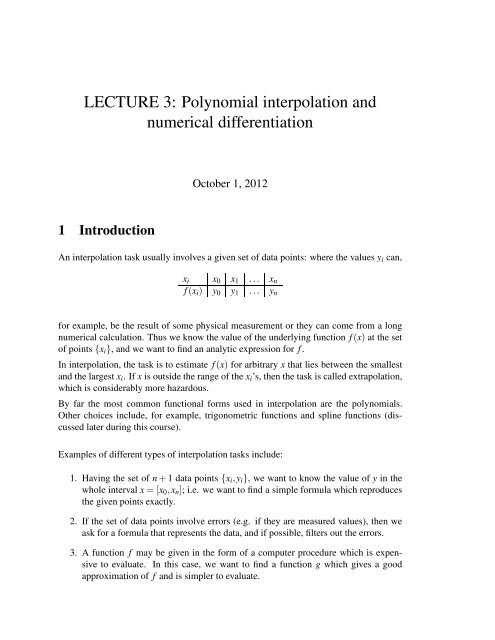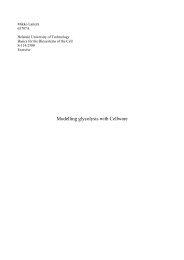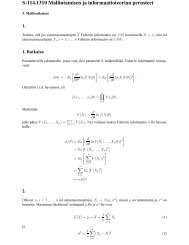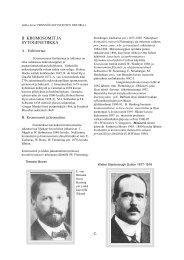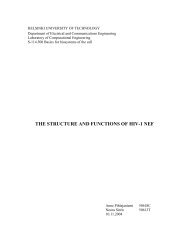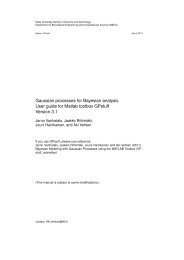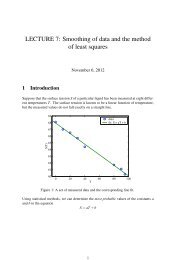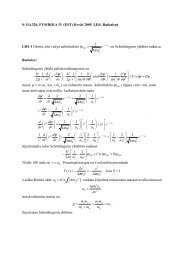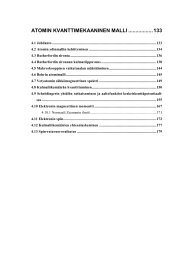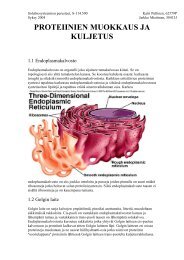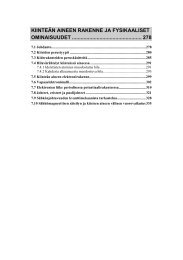LECTURE 3: Polynomial interpolation and numerical differentiation
LECTURE 3: Polynomial interpolation and numerical differentiation
LECTURE 3: Polynomial interpolation and numerical differentiation
Create successful ePaper yourself
Turn your PDF publications into a flip-book with our unique Google optimized e-Paper software.
<strong>LECTURE</strong> 3: <strong>Polynomial</strong> <strong>interpolation</strong> <strong>and</strong><br />
<strong>numerical</strong> <strong>differentiation</strong><br />
October 1, 2012<br />
1 Introduction<br />
An <strong>interpolation</strong> task usually involves a given set of data points: where the values y i can,<br />
x i x 0 x 1 ... x n<br />
f(x i ) y 0 y 1 ... y n<br />
for example, be the result of some physical measurement or they can come from a long<br />
<strong>numerical</strong> calculation. Thus we know the value of the underlying function f(x) at the set<br />
of points{x i }, <strong>and</strong> we want to find an analytic expression for f .<br />
In <strong>interpolation</strong>, the task is to estimate f(x) for arbitrary x that lies between the smallest<br />
<strong>and</strong> the largest x i . If x is outside the range of the x i ’s, then the task is called extrapolation,<br />
which is considerably more hazardous.<br />
By far the most common functional forms used in <strong>interpolation</strong> are the polynomials.<br />
Other choices include, for example, trigonometric functions <strong>and</strong> spline functions (discussed<br />
later during this course).<br />
Examples of different types of <strong>interpolation</strong> tasks include:<br />
1. Having the set of n+1 data points {x i ,y i }, we want to know the value of y in the<br />
whole interval x=[x 0 ,x n ]; i.e. we want to find a simple formula which reproduces<br />
the given points exactly.<br />
2. If the set of data points involve errors (e.g. if they are measured values), then we<br />
ask for a formula that represents the data, <strong>and</strong> if possible, filters out the errors.<br />
3. A function f may be given in the form of a computer procedure which is expensive<br />
to evaluate. In this case, we want to find a function g which gives a good<br />
approximation of f <strong>and</strong> is simpler to evaluate.
2 <strong>Polynomial</strong> <strong>interpolation</strong><br />
2.1 Interpolating polynomial<br />
Given a set of n+1 data points {x i ,y i }, we want to find a polynomial curve that passes<br />
through all the points. Thus, we look for a continuous curve which takes on the values y i<br />
for each of the n+1 distinct x i ’s.<br />
A polynomial p for which p(x i )=y i when 0≤i≤n is said to interpolate the given set of<br />
data points. The points x i are called nodes.<br />
The trivial case is n=0. Here a constant function p(x)=y 0 solves the problem.<br />
The simplest case is n=1. In this case, the polynomial p is a straight line defined by<br />
( ) ( )<br />
x−x1 x−x0<br />
p(x)= y 0 + y 1<br />
x 0 − x 1 x 1 − x<br />
( ) 0<br />
y1 − y 0<br />
= y 0 + (x−x 0 )<br />
x 1 − x 0<br />
Here p is used for linear <strong>interpolation</strong>.<br />
As we will see, the interpolating polynomial can be written in a variety of forms, among<br />
these are the Newton form <strong>and</strong> the Lagrange form. These forms are equivalent in the<br />
sense that the polynomial in question is the one <strong>and</strong> the same (in fact, the solution to the<br />
<strong>interpolation</strong> task is given by a unique polynomial)<br />
We begin by discussing the conceptually simpler Lagrange form. However, a straightforward<br />
implementation of this form is somewhat awkward to program <strong>and</strong> unsuitable for<br />
<strong>numerical</strong> evaluation (e.g. the resulting algorithm gives no error estimate). The Newton<br />
form is much more convenient <strong>and</strong> efficient, <strong>and</strong> therefore, it is used as the basis for<br />
<strong>numerical</strong> algorithms.<br />
2.2 Lagrange form<br />
First define a system of n+1 special polynomials l i known as cardinal functions. These<br />
have the following property:<br />
{<br />
0 if i≠ j<br />
l i (x j )=δ i j =<br />
1 if i= j<br />
The cardinal functions l i can be written as the product of n linear functions (the variable<br />
x occurs only in the numerator of each term; the denominators are just numbers):<br />
( ) x−x j<br />
l i (x)= (0≤i≤n)<br />
x i − x j<br />
=<br />
n<br />
∏<br />
j≠i<br />
j=0<br />
( )( )<br />
x−x0 x−x1<br />
...<br />
x i − x 0 x i − x 1<br />
Thus l i is a polynomial of degree n.<br />
( )( ) ( )<br />
x−xi−1 x−xi+1 x−xn<br />
...<br />
x i − x i−1 x i − x i+1 x i − x n
Note that when l i (x) is evaluated at x=x i , each factor in the preceding equation becomes<br />
1. But when l i (x) is evaluated at some other node x j , one of the factors becomes 0, <strong>and</strong><br />
thus l i (x j )=0 for i≠ j.<br />
Once the cardinal functions are defined, we can interpolate any function f by the following<br />
Lagrange form of the <strong>interpolation</strong> polynomial:<br />
p n (x)=<br />
n<br />
∑<br />
i=0<br />
l i (x) f(x i )<br />
Writing out the summation, we get<br />
( ) ( ) ( )<br />
x−x1 x−xi x−xn<br />
p n (x)= ... ... f(x 0 ) +...+<br />
x 0 − x 1 x 0 − x i x 0 − x<br />
( )( ) ( )( n<br />
) ( )<br />
x−x0 x−x1 x−xi−1 x−xi+1 x−xn<br />
+ ...<br />
... f(x i ) +...+<br />
x i − x 0 x i − x 1 x i − x i−1 x i − x i+1 x i − x<br />
( ) ( ) ( )<br />
n<br />
x−x0 x−xi x−xn−1<br />
+ ... ...<br />
f(x n )<br />
x n − x 0 x n − x i x n − x n−1<br />
It is easy to check that this function passes through all the nodes, i.e. p n (x j )= f(x j )=y j .<br />
Since the function p n is a linear combination of the polynomials l i , it is itself a polynomial<br />
of degree n or less.<br />
Example.<br />
Find the Lagrange form of the interpolating polynomial for the following table of values:<br />
x 1/3 1/4 1<br />
y 2 −1 7<br />
The cardinal functions are:<br />
l 0 (x)= (x−1/4)(x−1)<br />
(1/3−1/4)(1/3−1) =−18(x−1/4)(x−1)<br />
l 1 (x)= (x−1/3)(x−1)<br />
(1/4−1/3)(1/4−1) = 16(x−1/3)(x−1)<br />
l 2 (x)= (x−1/3)(x−1/4)<br />
(1−1/3)(1−1/4) = 2(x−1/3)(x−1/4)<br />
Therefore, the interpolating polynomial in Lagrange’s form is<br />
p 2 (x)=−36(x−1/4)(x−1)<br />
− 16(x−1/3)(x−1)<br />
+ 14(x−1/3)(x−1/4)
2.3 Existence of interpolating polynomial<br />
Theorem. If points x 0 ,x 1 ,...,x n are distinct, then for arbitrary real values y 0 ,y 1 ,...,y n ,<br />
there is a unique polynomial p of degree≤n such that p(x i )=y i for 0≤i≤n.<br />
The theorem can be proven by inductive reasoning. Suppose that we have succeeded in<br />
finding a polynomial p that reproduces a part of the given set of data points; e.g. p(x i )=y i<br />
for 0≤i≤k.<br />
We then attempt to add another term to p such that the resulting curve will pass through<br />
yet another data point x k+1 . We consider<br />
where c is a constant to be determined.<br />
q(x)= p(x)+c(x−x 0 )(x−x 1 )...(x−x k )<br />
This is a polynomial <strong>and</strong> it reproduces the first k data points because p does so <strong>and</strong> the<br />
added term is 0 at each of the points x 0 ,x 1 ,...,x k .<br />
We now adjust the value of c in such a way that the new polynomial q takes the value y k+1<br />
at x k+1 . We obtain<br />
q(x k+1 )= p(x k+1 )+c(x k+1 − x 0 )(x k+1 − x 1 )...(x k+1 − x k )=y k+1<br />
The proper value of c can be obtained from this equation since all the x i ’s are distinct.
2.4 Newton form<br />
The inductive proof of the existence of interpolating polynomial theorem provides a<br />
method for constructing an interpolating polynomial. The method is known as the Newton<br />
algorithm.<br />
The method is based on constructing successive polynomials p 0 , p 1 , p 2 ,... until the desired<br />
degree n is reached (determined by the number of data points = n+1).<br />
The first polynomial is given by<br />
Adding the second term gives<br />
p 0 (x)=y 0<br />
p 1 (x)= p 0 (x)+c 1 (x−x 0 )=y 0 + c 1 (x−x 0 )<br />
Interpolation condition is p 1 (x 1 )=y 1 . Thus we obtain<br />
y 0 + c 1 (x 1 − x 0 )=y 1<br />
which leads to<br />
c 1 = y 1− y 0<br />
x 1 − x 0<br />
The value of c is evaluated <strong>and</strong> placed in the formula for p 1 .<br />
We then continue to the third term which is given by<br />
p 2 (x)= p 1 (x)+c 2 (x−x 0 )(x−x 1 )=y 0 + c 1 (x−x 0 )+c 2 (x−x 0 )(x−x 1 )<br />
We again impose the <strong>interpolation</strong> condition p 2 (x 2 )=y 2 <strong>and</strong> use it to calculate the value<br />
of c.<br />
The iteration for the kth polynomial is<br />
p k (x)= p k−1 (x)+c k (x−x 0 )(x−x 1 )...(x−x k−1 )<br />
In the end we obtain the Newton form of the interpolating polynomial:<br />
p n (x)=a 0 + a 1 (x−x 0 )+a 2 (x−x 0 )(x−x 1 )...+a n (x−x 0 )...(x−x n−1 )<br />
where the coefficients y 0 ,c 1 ,c 2 ,... have been denoted by a i .
Example.<br />
Find the Newton form of the interpolating polynomial for the following table of values:<br />
x 1/3 1/4 1<br />
y 2 −1 7<br />
We will construct three successive polynomials p 0 , p 1 <strong>and</strong> p 2 . The first one is<br />
p 0 (x)=2<br />
The next one is given by<br />
p 1 (x)= p 0 (x)+c 1 (x−x 0 )=2+c 1 (x−1/3)<br />
Using the <strong>interpolation</strong> condition p 1 (1/4)=−1, we obtain c 1 = 36, <strong>and</strong><br />
p 1 (x)=2+36(x−1/3)<br />
Finally,<br />
p 2 (x)= p 1 (x)+c 2 (x−x 0 )(x−x 1 )<br />
= 2+36(x−1/3)+c 2 (x−1/3)(x−1/4)<br />
The <strong>interpolation</strong> condition gives p 2 (1)=7, <strong>and</strong> thus c 2 =−38.<br />
The Newton form of the interpolating polynomial is<br />
p 2 (x)=2+36(x−1/3)−38(x−1/3)(x−1/4)<br />
Comparison of Lagrange <strong>and</strong> Newton forms<br />
Lagrange form<br />
p 2 (x)=−36(x−1/4)(x−1)<br />
− 16(x−1/3)(x−1)<br />
+ 14(x−1/3)(x−1/4)<br />
Newton form<br />
p 2 (x)=2+36(x−1/3)−38(x−1/3)(x−1/4)<br />
These two polynomials are equivalent, i.e:<br />
p 2 (x)=−38x 2 +(349/6)x−79/6
2.5 Nested multiplication<br />
For efficient evaluation, the Newton form can be rewritten in a so-called nested form. This<br />
form is obtained by systematic factorisation of the original polynomial.<br />
Consider a general polynomial in the Newton form<br />
p n (x)=a 0 + a 1 (x−x 0 )+a 2 (x−x 0 )(x−x 1 )...+a n (x−x 0 )...(x−x n−1 )<br />
This can be written as<br />
p n (x)=a 0 +<br />
n<br />
∑<br />
i=1<br />
[ ]<br />
i−1<br />
a i (x−x j )<br />
∏<br />
j=0<br />
Let us now rewrite the Newton form of the interpolating polynomial in the nested form<br />
by using the common terms(x−x i ) for factoring. We obtain<br />
p n (x)=a 0 +(x−x 0 )(a 1 +(x−x 1 )(a 2 +(x−x 2 )(a 3 +...+(x−x n−1 )a n )...))<br />
This is called the nested form <strong>and</strong> its evaluation is done by nested multiplication.<br />
When evaluating p(x) for a given <strong>numerical</strong> value of x = t, we naturally begin with the<br />
innermost parenthesis:<br />
The quantity v n is p(t).<br />
v 0 = a n<br />
v 1 = v 0 (t− x n−1 )+a n−1<br />
v 2 = v 1 (t− x n−2 )+a n−2<br />
.<br />
v n = v n−1 (t− x 0 )+a 0<br />
In the actual implementation, we only need one variable v. The following pseudocode<br />
shows how the evaluation of p(x = t) is done efficiently once the coefficients a i of the<br />
Newton form are known. The array (x i ) 0:n contains the n+1 nodes x i .<br />
real array (a i ) 0:n ,(x i ) 0:n<br />
integer i,n<br />
real t,v<br />
v←a n<br />
for i=n-1 to 0 step -1 do<br />
v←v(t− x i )+a i<br />
end for
2.6 Divided differences<br />
The next step is to discuss a method for determining the coefficients a i efficiently. We start<br />
with a table of values of a function f : We have seen that there exists a unique polynomial<br />
x x 0 x 1 ... x n<br />
f(x) f(x 0 ) f(x 1 ) ... f(x n )<br />
p of degree≤n. In the compact notation of the Newton form p is written as<br />
[ ]<br />
n i−1<br />
p n (x)= a i (x−x j )<br />
∑<br />
i=0<br />
in which ∏ −1<br />
j=0 (x−x j) is interpreted as 1.<br />
Notice that the coefficients a i do not depend on n. In other words, p n is obtained from<br />
p n−1 by adding one more term, without altering the coefficients already present in p n−1 .<br />
A way of systematically determining the coefficients a i is to set x equal to each of the<br />
points x i (0≤i≤n) at a time. The resulting equations are:<br />
⎧<br />
f(x 0 ) = a 0<br />
⎪⎨ f(x 1 ) = a 0 + a 1 (x 1 − x 0 )<br />
In compact form<br />
∏<br />
j=0<br />
f(x 2 ) = a 0 + a 1 (x 2 − x 0 )+a 2 (x 2 − x 0 )(x 2 − x 1 )<br />
⎪⎩<br />
.<br />
f(x k )=<br />
k i−1<br />
∑ a i ∏<br />
i=0 j=0<br />
(x k − x j ) (0≤k≤n)<br />
The coefficients a k are uniquely determined by these equations. The coefficients can now<br />
be solved starting with a 0 which depends on f(x 0 ), followed by a 1 which depends on<br />
f(x 0 ) <strong>and</strong> f(x 1 ), <strong>and</strong> so on.<br />
In general, a k depends on the values of f at the nodes x 0 ,...,x k . This dependence is<br />
formally written in the following notation<br />
a k = f[x 0 ,x 1 ,...,x k ]<br />
The quantity f[x 0 ,x 1 ,...,x k ] is called the divided difference of order k for f .<br />
(Suomeksi: jaettu erotus.)
Example. Determine the quantities f[x 0 ], f[x 0 ,x 1 ], <strong>and</strong> f[x 0 ,x 1 ,x 2 ] for the following table<br />
x 1 -4 0<br />
f(x) 3 13 -23<br />
The system of equations for the coefficients a k :<br />
⎧<br />
⎪⎨ 3 = a 0<br />
13 = a 0 + a 1 (−4−1)<br />
⎪⎩<br />
−23 = a 0 + a 1 (0−1)+a 2 (0−1)(0+4)<br />
We get ⎧<br />
⎪⎨<br />
⎪ ⎩<br />
a 0 = 3<br />
a 1<br />
=[13−a 0 ]/(−4−1)=−2<br />
a 2 =[−23−a 0 − a 1 (0−1)]/(0+4)= 7<br />
Thus for this function, f[1]=3, f[1,−4]=−2, <strong>and</strong> f[1,−4,0]=7.<br />
With the new notation for divided differences, the Newton form of the interpolating<br />
polynomial takes the form<br />
{<br />
}<br />
i−1<br />
p n (x)= f[x 0 ,x 1 ,...,x i ] (x−x j )<br />
n<br />
∑<br />
i=0<br />
∏<br />
j=0<br />
The required divided differences f[x 0 ,x 1 ,...,x k ] (the coefficients) can be computed recursively.<br />
We can write<br />
f(x k )=<br />
k i−1<br />
∑ a i ∏<br />
i=0 j=0<br />
(x k − x j )<br />
k−1<br />
= f[x 0 ,x 1 ,...,x k ]<br />
∏<br />
j=0<br />
(x k − x j )+<br />
k−1<br />
∑<br />
i=0<br />
i−1<br />
f[x 0 ,x 1 ,...,x i ]<br />
∏<br />
j=0<br />
(x k − x j )<br />
<strong>and</strong><br />
f[x 0 ,x 1 ,...,x k ]= f(x k)−∑ k−1<br />
i=0 f[x 0,x 1 ,...,x i ]∏ i−1<br />
j=0 (x k− x j )<br />
∏ k−1<br />
j=0 (x k− x j )<br />
Thus one possible algorithm for computing the divided differences is<br />
i. Set f[x 0 ]= f(x 0 ).<br />
ii. For k=1,2,...,n, compute f[x 0 ,x 1 ,...,x k ] by the equation above.
This can be easily programmed; the algorithm is capable of computing the divided differences<br />
at the cost of 1 2n(3n+1) additions/subtractions,(n−1)(n−2) multiplications, <strong>and</strong><br />
n divisions.<br />
There is, however, a more refined method for calculating the divided differences.
2.7 Recursive property of divided differences<br />
The efficient method for calculating the divided differences is based on two properties of<br />
the divided differences.<br />
First, the divided differences obey the formula (the recursive property of divided differences)<br />
f[x 0 ,x 1 ,...,x k ]= f[x 1,x 2 ,...,x k ]− f[x 0 ,x 1 ,...,x k−1 ]<br />
x k − x 0<br />
The proof is left to the student (see e.g., Cheney <strong>and</strong> Kincaid, pp. 134, Theorem 2).<br />
Second, because of the uniqueness of the interpolating polynomials, the divided differences<br />
are not changed if the nodes are permuted. This is expressed more formally by the<br />
following theorem.<br />
Invariance theorem.<br />
The divided difference f[x 0 ,x 1 ,...,x k ] is invariant under all permutations of the arguments<br />
x 0 ,x 1 ,...,x k .<br />
Thus, the recursive formula can also be written as<br />
f[x i ,x i+1 ,...,x j−1 ,x j ]= f[x i+1,x i+2 ,...,x j ]− f[x i ,x i+1 ,...,x j−1 ]<br />
x j − x i<br />
We can now determine the divided differences as follows:<br />
f[x i ]= f(x i ) f[x i+1 ]= f(x i+1 ) f[x i+2 ]= f(x i+2 )<br />
f[x i ,x i+1 ]= f[x i+1]− f[x i ]<br />
x i+1 − x i<br />
f[x i+1 ,x i+2 ]= f[x i+2]− f[x i+1 ]<br />
x i+2 − x i+1<br />
f[x i ,x i+1 ,x i+2 ] = f[x i+1,x i+2 ]− f[x i ,x i+1 ]<br />
x i+2 − x i
Using the recursive formula, we can now construct a divided-differences table for a function<br />
f<br />
x f[] f[, ] f[, , ] f[, , , ]<br />
x 0 f[x 0 ]<br />
f[x 0 ,x 1 ]<br />
x 1 f[x 1 ] f[x 0 ,x 1 ,x 2 ]<br />
f[x 1 ,x 2 ] f[x 0 ,x 1 ,x 2 ,x 3 ]<br />
x 2 f[x 2 ] f[x 1 ,x 2 ,x 3 ]<br />
f[x 2 ,x 3 ]<br />
x 3 f[x 3 ]<br />
Example.<br />
Construct a divided differences table <strong>and</strong> write out the Newton form of the interpolating<br />
polynomial for the following table of values:<br />
x i 1 3/2 0 3<br />
f(x i ) 3 13/4 3 5/3<br />
Step 1.<br />
The second column of entries is given by f[x i ]= f(x i ). Thus<br />
x f[] f[, ] f[, , ] f[, , , ]<br />
1 3<br />
f[x 0 ,x 1 ]<br />
3/2 13/4 f[x 0 ,x 1 ,x 2 ]<br />
f[x 1 ,x 2 ] f[x 0 ,x 1 ,x 2 ,x 3 ]<br />
0 3 f[x 1 ,x 2 ,x 3 ]<br />
f[x 2 ,x 3 ]<br />
2 5/3<br />
Step 2.<br />
The third column of entries is obtained using the values in the second column:<br />
f[x i ,x i+1 ]= f[x i+1]− f[x i ]<br />
x i+1 − x i<br />
For example,<br />
f[x 0 ,x 1 ]= f[x 1]− f[x 0 ]<br />
x 1 − x 0<br />
= 13/4−3<br />
3/2−1 = 1 2
The table with a completed second column is<br />
x f[] f[, ] f[, , ] f[, , , ]<br />
1 3<br />
1/2<br />
3/2 13/4 f[x 0 ,x 1 ,x 2 ]<br />
1/6 f[x 0 ,x 1 ,x 2 ,x 3 ]<br />
0 3 f[x 1 ,x 2 ,x 3 ]<br />
-2/3<br />
2 5/3<br />
Step 3.<br />
The first entry in the fourth column is obtained using the values in the third column:<br />
f[x 0 ,x 1 ,x 2 ] = f[x 1,x 2 ]− f[x 0 ,x 1 ]<br />
x 2 − x 0<br />
The table with a completed third column is<br />
x f[] f[, ] f[, , ] f[, , , ]<br />
= 1/6−1/2<br />
0−1<br />
1 3<br />
1/2<br />
3/2 13/4 1/3<br />
1/6 f[x 0 ,x 1 ,x 2 ,x 3 ]<br />
0 3 -5/3<br />
-2/3<br />
2 5/3<br />
= 1 3<br />
Step 4.<br />
The final entry in the table is<br />
The completed table is<br />
f[x 0 ,x 1 ,x 2 ,x 3 ] = f[x 1,x 2 ,x 3 ]− f[x 0 ,x 1 ,x 2 ]<br />
x 3 − x 0<br />
x f[] f[, ] f[, , ] f[, , , ]<br />
1 3<br />
1/2<br />
3/2 13/4 1/3<br />
1/6 -2<br />
0 3 -5/3<br />
-2/3<br />
2 5/3<br />
= −5/3−1/3<br />
2−1<br />
=−2
Using the values shown in bold text in the divided differences table, we can now write out<br />
the Newton form of the interpolating polynomial. We get<br />
{<br />
}<br />
i−1<br />
p n (x)= f[x 0 ,x 1 ,...,x i ] (x−x j )<br />
n<br />
∑<br />
i=0<br />
∏<br />
j=0<br />
= f[x 0 ]+ f[x 0 ,x 1 ](x−x 0 )+ f[x 0 ,x 1 ,x 2 ](x−x 0 )(x−x 1 )<br />
+ f[x 0 ,x 1 ,x 2 ,x 3 ](x−x 0 )(x−x 1 )(x−x 2 )<br />
= 3+ 1 2 (x−1)+ 1 3 (x−1)(x− 3 2 )−2(x−1)(x− 3 2 )x<br />
2.8 Algorithms<br />
We now use the same procedure to construct an algorithm which computes all the divided<br />
differences a i j ≡ f[x i ,x i+1 ,...,x j ].<br />
Notice that there is no need to store all the values in the table since only f[x 0 ], f[x 0 ,x 1 ],..., f[x 0 ,x 1 ,...,x n ]<br />
are needed to construct the Newton form of the interpolating polynomial.<br />
Denote a i ≡ f[x 0 ,x 1 ,...,x i ]. Using this notation, the Newton form is given by<br />
p n (x)=<br />
n i−1<br />
∑ a i ∏<br />
i=0 j=0<br />
(x−x j )<br />
We can use a one-dimensional array (a i ) 0:n for storing the divided differences <strong>and</strong> overwrite<br />
the entries each time from the last storage location backward. At each step, the new<br />
value of each new divided difference is obtained using the recursion formula:<br />
a i ←(a i − a i−1 )/(x i − x i− j )<br />
where j is the index of the step in question (j=1,. . . ,n).
The following procedure Coefficients calculates the coefficients a i required in the Newton<br />
interpolating polynomial. The input is the number n (degree of the polynomial) <strong>and</strong> the<br />
arrays for x i , y i <strong>and</strong> a i (all contain n+1 elements). The arrays x i <strong>and</strong> y i contain the data<br />
points. a i is the array where the coefficients are to be computed.<br />
void Coefficients(int n, double *x, double *y, double *a)<br />
{<br />
int i, j;<br />
for(i=0; i
The procedure Evaluate returns the value of the interpolating polynomial at point t. The<br />
input is the array x i <strong>and</strong> the array a i which is obtained using the procedure Coefficients.<br />
Also the value of the point t is given.<br />
double Evaluate(int n, double *x, double *a, double t)<br />
{<br />
int i;<br />
double pt;<br />
pt = a[n];<br />
for(i=n-1; i>=0; i--)<br />
pt = pt*(t-x[i])+a[i];<br />
}<br />
return(pt);<br />
Notice that only the value of t should change in subsequent calls of Evaluate.<br />
These procedures Coefficients <strong>and</strong> Evaluate can be used to construct a program that determines<br />
the Newton form of the interpolating polynomial for a given function f(x). In<br />
such a program, the procedure Coefficients is called once to determine the coefficients <strong>and</strong><br />
then the procedure Evaluate is called as many time as needed to determine the value of<br />
the interpolating polynomial at some given set points of interest.<br />
Example.<br />
In the following example, the task is to find the interpolating polynomial for the function<br />
f(x)=sin(x) at ten equidistant points in the interval [0,1.6875] (these ten points are the<br />
nodes). The value of the resulting polynomial p(x) is then evaluated at 37 equally spaced<br />
points in the same interval <strong>and</strong> also the absolute error| f(x)− p(x)| is calculated.<br />
Output<br />
The following coefficients for the Newton form of the interpolating polynomial are obtained:<br />
i ai<br />
0 0.00000000<br />
1 0.99415092<br />
2 -0.09292892<br />
3 -0.15941590<br />
4 0.01517217<br />
5 0.00738018<br />
6 -0.00073421<br />
7 -0.00015560<br />
8 0.00001671<br />
9 0.00000181
Figure 1 shows a plot of the data points f(x i )=sin(x i ), 0 ≤ i ≤ 9 <strong>and</strong> the interpolating<br />
polynomial (evaluated at 37 points).<br />
1<br />
0.8<br />
f(x)<br />
0.6<br />
0.4<br />
0.2<br />
0<br />
0 0.5 1 1.5<br />
x<br />
Figure 1: A plot of the original data points (nodes) <strong>and</strong> the interpolating polynomial.<br />
From Fig. 2, we see that the deviation between p(x) <strong>and</strong> f(x) is zero at each <strong>interpolation</strong><br />
node (within the accuracy of the computer). Between the nodes, we obtain deviations that<br />
are less than 5×10 −10 in magnitude.
6 x 10-10<br />
5<br />
4<br />
3<br />
2<br />
1<br />
0<br />
0 5 10 15 20 25 30 35<br />
Figure 2: The absolute error| f(x)− p(x)| between the interpolating polynomial p <strong>and</strong> the<br />
underlying function f at the 37 <strong>interpolation</strong> points.
2.9 Inverse <strong>interpolation</strong><br />
A process called inverse <strong>interpolation</strong> can be used to approximate an inverse function.<br />
Suppose that the values y i = f(x i ) have been computed at x 0 ,x 1 ,...,x n .<br />
We can form the <strong>interpolation</strong> polynomial as<br />
p(y)=<br />
n i−1<br />
∑ c i ∏<br />
i=0 j=0<br />
(y−y j )<br />
The original relationship y = f(x) has an inverse under certain conditions. This can be<br />
approximated by x= p(y).<br />
The procedures Coefficients <strong>and</strong> Evaluate can be used to carry out the inverse <strong>interpolation</strong><br />
by reversing the arguments x <strong>and</strong> y.<br />
Inverse <strong>interpolation</strong> can be used to locate the root of a given function f ; i.e. we want to<br />
solve f(x)=0. First create a set of function values { f(x i ),x i } <strong>and</strong> find the interpolating<br />
polynomial p(y i )=x i .<br />
The approximate root is now given by r≈ p(y=0).<br />
Example.<br />
Having the following set of values<br />
y x<br />
-0.57892000 1.00000000<br />
-0.36263700 2.00000000<br />
-0.18491600 3.00000000<br />
-0.03406420 4.00000000<br />
0.09698580 5.00000000<br />
We can use the <strong>interpolation</strong> program with<br />
x←y <strong>and</strong> y←x.<br />
This gives us the coefficients for the polynomial p(y).<br />
Evaluating p at point y=0, gives p(0)=4.24747001.
2.10 Neville’s algorithm<br />
Another widely used method for obtaining the interpolating polynomial for a given table<br />
of values is given by Neville’s algorithm. It builds up the polynomial in steps, just as the<br />
Newton algorithm does.<br />
Let P a,b,...,s be the polynomial interpolating the given data at a sequence of nodes x a ,x b ,...,x s .<br />
We start with constant polynomials P i (x)= f(x i ). Selecting two nodes x i <strong>and</strong> x j with i> j,<br />
we define recursively<br />
( ) ( )<br />
x−x j<br />
xi − x<br />
P u,...,v (x)= P u,..., j−1, j+1,...,v (x)+ P u,...,i−1,i+1,...,v (x)<br />
x i − x j x i − x j<br />
For example, the first three constant polynomials are<br />
P 0 (x)= f(x 0 ) P 1 (x)= f(x 1 ) P 2 (x)= f(x 2 )<br />
Using P 0 <strong>and</strong> P 1 , we can construct P 0,1 :<br />
( ) ( )<br />
x−x0 x1 − x<br />
P 0,1 (x)= P 1 + P 0<br />
x 1 − x 0 x 1 − x 0<br />
<strong>and</strong> similarly<br />
P 1,2 (x)=<br />
( ) ( )<br />
x−x1 x2 − x<br />
P 2 + P 1<br />
x 2 − x 1 x 2 − x 1<br />
Using these two polynomials of degree one, we can construct another polynomial of degree<br />
two: ( ) ( )<br />
x−x0 x2 − x<br />
P 0,1,2 (x)= P 1,2 + P 0,1<br />
x 2 − x 0 x 2 − x 0<br />
Similarly,<br />
P 0,1,2,3 (x)=<br />
( ) ( )<br />
x−x0<br />
x3 − x<br />
P 1,2,3 + P 0,1,2<br />
x 3 − x 0 x 3 − x 0<br />
Using this formula repeatedly, we can create an array of polynomials:<br />
x 0<br />
x 1<br />
x 2<br />
x 3<br />
x 4<br />
P 0 (x)<br />
P 1 (x) P 0,1 (x)<br />
P 2 (x) P 1,2 (x) P 0,1,2 (x)<br />
P 3 (x) P 2,3 (x) P 1,2,3 (x) P 0,1,2,3 (x)<br />
P 4 (x) P 3,4 (x) P 2,3,4 (x) P 1,2,3,4 (x) P 0,1,2,3,4 (x)<br />
Here each successive polynomial can be determined from two adjacent polynomials in<br />
the previous column.
We can simplify the notation by<br />
S i j (x)=P i− j,i− j+1,...,i−1,i (x)<br />
where S i j (x) for i≥ j denotes the interpolating polynomial of degree j on the j+ 1 nodes<br />
x i− j ,x i− j+1 ,...,x i−1 ,x i . For example, S 44 is the interpolating polynomial of degree 4 on<br />
the five nodes x 0 ,x 1 ,x 2 ,x 3 <strong>and</strong> x 4 .<br />
Using this notation, we can rewrite the recurrence relation as<br />
( ) ( )<br />
x−xi− j<br />
xi − x<br />
S i j (x)=<br />
S i, j−1 (x)+<br />
S i−1, j−1 (x)<br />
x i − x i− j x i − x i− j<br />
The array becomes<br />
x 0<br />
x 1<br />
x 2<br />
x 3<br />
x 4<br />
S 00 (x)<br />
S 10 (x) S 11 (x)<br />
S 20 (x) S 21 (x) S 22 (x)<br />
S 30 (x) S 31 (x) S 32 (x) S 33 (x)<br />
S 40 (x) S 41 (x) S 42 (x) S 43 (x) S 44 (x)<br />
Algorithm<br />
A pseudocode to evaluate S nn (x) at point x=t can be written as follows:<br />
real array (x i ) 0:n ,(y i ) 0:n ,(S i j ) 0:n×0:n<br />
integer i, j,n<br />
for i=0 to n<br />
S i0 ← y i<br />
end for<br />
for j=1 to n<br />
for i=j to n<br />
S i j ←[(t− x i− j )S i, j−1 +(x i −t)S i−1, j−1 ]/(x i − x i− j )<br />
end for<br />
end for<br />
return S nn<br />
Here (x i ) 0:n <strong>and</strong> (y i ) 0:n are the arrays containing the initial data points, <strong>and</strong> the procedure<br />
returns the value of the interpolating polynomial at point x=t.
3 Errors in polynomial <strong>interpolation</strong><br />
When a function f is approximated on an interval [a,b] by an interpolating polynomial<br />
p, the discrepancy between f <strong>and</strong> p will be zero at each node, i.e., p(x i ) = f(x i ) (at<br />
least theoretically). Based on this, it is easy to expect that when the number of nodes n<br />
increases, the function f will be better approximated at all intermediate points as well.<br />
This is wrong. In many cases, high-degree polynomials can be very unsatisfactory representations<br />
of functions even if the function is continuous <strong>and</strong> well-behaved.<br />
Example. Consider the Runge function:<br />
f(x)= 1<br />
1+x 2<br />
on the interval [-5,5]. Let p n be the polynomial that interpolates this function at n+1<br />
equally spaced points on the interval [-5,5]. Then<br />
lim<br />
max<br />
n→∞−5≤x≤5 | f(x)− p(x)|=∞<br />
Thus increasing the number of node points increases the error at nonnodal points beyond<br />
all bounds! Figure 3 below shows f <strong>and</strong> p for n=9.<br />
1<br />
0.8<br />
0.6<br />
0.4<br />
0.2<br />
0<br />
-0.2<br />
-0.4<br />
-5 0 5<br />
Figure 3: The Runge function f (shown in dashed line) <strong>and</strong> the polynomial interpolant p<br />
obtained using 9 equidistant nodes.
3.1 Choice of nodes<br />
Contrary to intuition, equally distributed nodes are usually not the best choice in <strong>interpolation</strong>.<br />
A much better choice for n+1 nodes in [-1,1] is the set of Chebyshev nodes:<br />
[( ] i<br />
x i = cos π (0≤i≤n)<br />
n)<br />
The corresponding set of nodes on an arbitrary interval [a,b] can be derived from a linear<br />
mapping to obtain<br />
x i = 1 2 (a+b)+ 1 [ ] i<br />
2 (b−a)cos n π (0≤i≤n)<br />
Notice that the Chebyshev nodes are numbered from right to left (i.e.the largest value has<br />
the lowest index).<br />
Figure 4 shows the polynomial interpolant of the Runge function obtained with 13 Chebyshev<br />
nodes.<br />
1<br />
0.8<br />
0.6<br />
0.4<br />
0.2<br />
0<br />
-0.2<br />
-0.4<br />
-5 0 5<br />
Figure 4: The Runge function f (shown in dashed line) <strong>and</strong> the polynomial interpolant p<br />
obtained using 13 Chebyshev nodes.
3.2 Theorems on <strong>interpolation</strong> errors<br />
Theorem 1.<br />
If p is the polynomial of degree at most n that interpolates f at the n+1 distinct nodes<br />
x i (0 ≤ i ≤ n) belonging to an interval [a,b] <strong>and</strong> if f (n+1) (the nth derivative of f ) is<br />
continuous, then for each x in [a,b], there is a ξ in(a,b) for which<br />
1<br />
f(x)− p(x)=<br />
(n+1)! f(n+1) (ξ)<br />
n<br />
∏<br />
i=0<br />
(x−x i )<br />
Theorem 2.<br />
Let f be a function such that f (n+1) is continuous on [a,b] <strong>and</strong> satisfies | f (n+1) (x)|≤M.<br />
Let p be the polynomial of degree ≤ n that interpolates f at n+1 equally spaced nodes<br />
in[a,b], including the endpoints. Then on[a,b],<br />
| f(x)− p(x)|=<br />
( )<br />
1 b−a n+1<br />
4(n+1) M n<br />
Theorem 3.<br />
If p is the polynomial of degree n that interpolates the function f at nodes x i (0≤i≤n),<br />
then for any x not a node<br />
f(x)− p(x)= f[x 0 ,x 1 ,...,x n ,x]<br />
n<br />
∏<br />
i=0<br />
(x−x i )
Example.<br />
In a previous example, we constructed the interpolating polynomial of f(x) = sin(x) at<br />
ten equidistant points in [0,1.6875].<br />
Figure 5 shows a plot of the computed error | f(x)− p(x)|. At the largest, the error is<br />
approximately 5×10 −10 .<br />
6 x 10-10<br />
5<br />
4<br />
3<br />
2<br />
1<br />
0<br />
0 5 10 15 20 25 30 35<br />
Figure 5: The absolute error | f(x)− p(x)| in polynomial <strong>interpolation</strong> of f(x) = sin(x)<br />
using ten equidistant nodes.<br />
Now use Theorem 2 with f(x)=sin(x), n=9, a=0<strong>and</strong> b=1.6875. The 10th derivative<br />
of f is f (10) (x)=−sin(x), <strong>and</strong> thus| f (10) (x)|≤1. Thus we can let M = 1.<br />
The resulting bound for the error is<br />
| f(x)− p(x)|≤<br />
( )<br />
1 b−a n+1<br />
4(n+1) M = 1.34×10 −9<br />
n
Divided differences & derivatives theorem.<br />
If f (n) is continuous on[a,b] <strong>and</strong> if x 0 ,x 1 ,...,x n are any n+1 distinct points in[a,b], then<br />
for some ξ in (a,b),<br />
f[x 0 ,x 1 ,...,x n ]= 1 n! f(n) (ξ)<br />
Divided differences corollary.<br />
If f is a polynomial of degree n, then all of the divided differences<br />
f[x 0 ,x 1 ,...,x i ] are zero for i≥n+1.<br />
Example.<br />
Consider the following table of values:<br />
x 1 −2 0 3 −1 7<br />
y −2 −56 −2 4 −16 376<br />
Constructing a divided differences table shows that the fourth-order divided differences<br />
are all zero.<br />
x f[] f[, ] f[, , ] f[, , , ] f[, , , , ]<br />
1 -2<br />
18<br />
-2 -56 -9<br />
27 2<br />
0 -2 -5 0<br />
2 2<br />
3 4 -3 0<br />
5 2<br />
-1 -16 11<br />
49<br />
7 376<br />
The Newton form of the <strong>interpolation</strong> polynomial is<br />
p 3 (x)=−2+18(x−1)−9(x−1)(x+2)+2(x−1)(x+2)x<br />
Thus the data can be represented by a cubic polynomial because all the fourth-order divided<br />
differences are zero.
4 Numerical <strong>differentiation</strong><br />
We now move on to a slightly different subject, namely <strong>numerical</strong> <strong>differentiation</strong>. This<br />
subject is often not discussed in great detail, but we include it here because the central<br />
idea of a process called Richardson extrapolation is also used in <strong>numerical</strong> integration.<br />
Determining the derivative of a function f at point x is not a trivial <strong>numerical</strong> problem.<br />
Specifically, if f(x) can be computed with n digits of precision, it is difficult to calculate<br />
f ′ (x) <strong>numerical</strong>ly with n digits of precision. This is caused by subtraction of nearly equal<br />
quantities (loss of precision).<br />
4.1 First-derivative formulas via Taylor series<br />
Consider first the obvious method based on the definition of f ′ (x):<br />
f ′ (x)≈ 1 [ f(x+h)− f(x)]<br />
h<br />
What is the error involved in this formula? By Taylor’s theorem:<br />
Rearranging this gives:<br />
f(x+h)= f(x)+h f ′ (x)+ 1 2 h2 f ′′ (ξ)<br />
f ′ (x)= 1 h [ f(x+h)− f(x)]− 1 2 h f′′ (ξ)<br />
We see that the first approximation has a truncation error − 1 2 h f′′ (ξ) where ξ is in the<br />
interval [x,x+h]. In general, as h → 0, the error approaches zero at the same rate as h<br />
does - that is O(h).<br />
It is advantageous to have the convergence of <strong>numerical</strong> processes occur with high powers<br />
of some quantity approaching zero. In the present case, we want an approximation to f ′ (x)<br />
in which the error behaves like O(h 2 ).<br />
One such method is obtained using the following two Taylor series:<br />
{<br />
f(x+h)= f(x)+h f ′ (x)+ 1 2! h2 f ′′ (x)+ 1 3! h3 f ′′′ (x)+ 1 4! h3 f (4) (x)+...<br />
f(x−h)= f(x)−h f ′ (x)+ 1 2! h2 f ′′ (x)− 1 3! h3 f ′′′ (x)+ 1 4! h4 f (4) (x)−...<br />
By subtraction, we obtain<br />
f(x+h)− f(x−h)=2h f ′ (x)+ 2 3! h3 f ′′′ (x)+ 2 5! h5 f (5) (x)+...<br />
From this we obtain the following formula for f ′ :<br />
f ′ (x)= 1<br />
2h [ f(x+h)− f(x−h)]− 1 3! h2 f ′′′ (x)− 1 5! h4 f (5) (x)−...
Thus we obtain an approximation formula for f ′ with an error whose leading term is<br />
− 1 6 h2 f ′′′ (x), which makes it O(h 2 ):<br />
f ′ (x)≈ 1 [ f(x+h)− f(x−h)]<br />
2h<br />
The approximation formula with the error term can be written as<br />
f ′ (x)≈ 1<br />
2h [ f(x+h)− f(x−h)]− 1 6 h2 f ′′′ (ξ)<br />
where ξ is some point on the interval [x−h,x+h]. This is based only on the assumption<br />
that f ′′′ is continuous on[x−h,x+h].<br />
4.2 Richardson extrapolation<br />
Richardson extrapolation is a powerful technique for obtaining accurate results from a<br />
<strong>numerical</strong> process such as the approximation formula for f ′ obtained via Taylor series:<br />
f ′ (x)≈ 1<br />
2h [ f(x+h)− f(x−h)]+a 2h 2 + a 4 h 4 + a 6 h 6 +...<br />
where the constants a i depend on f <strong>and</strong> x.<br />
Holding f <strong>and</strong> x fixed, we define a function of h by the formula<br />
ϕ(h)≈ 1 [ f(x+h)− f(x−h)]<br />
2h<br />
where ϕ(h) is an approximation to f ′ (x) with an error of order O(h 2 ).<br />
Our objective is to compute the limit lim h→0 ϕ(h) because this is the quantity f ′ (x). Since<br />
we cannot actually compute the value of ϕ(0) from the equation above, Richardson extrapolation<br />
seeks to estimate the limiting value at 0 from some computed values of ϕ near<br />
0.<br />
Suppose now that we compute ϕ(h) <strong>and</strong> ϕ(h/2) for some h:<br />
{<br />
ϕ(h)= f ′ (x)−a 2 h 2 − a 4 h 4 − a 6 h 6 −...<br />
ϕ( h 2 )= f′ (x)−a 2<br />
( h2<br />
) 2−<br />
a4<br />
( h2<br />
) 4−<br />
a6<br />
( h2<br />
) 6−...<br />
We can now use simple algebra to eliminate the dominant term in the error series. We<br />
multiply the bottom series by 4 <strong>and</strong> subtract it from the top equation. The result is<br />
ϕ(h)−4ϕ( h 2 )=−3 f′ (x)− 3 4 a 4h 4 − 15<br />
16 a 6h 6 −...<br />
Divide this by -3 <strong>and</strong> rearrange to get<br />
ϕ( h 2 )+ 1 [ϕ( h ]<br />
3 2 )−ϕ(h) = f ′ (x)+ 1 4 a 4h 4 + 5<br />
16 a 6h 6 +...<br />
Thus we have improved the precision to O(h 4 )!! The same procedure can be repeated over<br />
<strong>and</strong> over again to "kill" higher order terms from the error series. This is called Richardson<br />
extrapolation.
4.3 Richardson extrapolation theorem<br />
The same procedure will be needed later in the derivation of the Romberg’s algorithm for<br />
<strong>numerical</strong> integration. We therefore want to have a general discussion of the procedure.<br />
Let ϕ be a function such that<br />
ϕ(h)=L−<br />
∞<br />
∑<br />
k=1<br />
a 2k h 2k<br />
where the coefficients a 2k are not known. It is assumed that ϕ(h) can be computed accurately<br />
for any h>0. Our objective is to approximate L accurately using ϕ.<br />
We select a convenient h <strong>and</strong> compute the numbers<br />
We have<br />
D(n,0)= ϕ( h 2n) (n≥0)<br />
D(n,0)=L+<br />
∞<br />
∑<br />
k=1<br />
( ) h 2k<br />
A(k,0)<br />
2 n<br />
where A(k,0)=−a 2k . These numbers D(n,0) give a crude estimate of the unknown number<br />
L=lim x→0 ϕ(x).<br />
More accurate estimates are obtained via Richardson extrapolation:<br />
D(n,m)= 4m<br />
4 m − 1 D(n,m−1)− 1<br />
4 m − 1 D(n−1,m−1)<br />
This is called the Richardson extrapolation formula.<br />
Theorem.<br />
The quantities D(n,m) obey the equation<br />
D(n,m)=L+<br />
∞<br />
∑<br />
k=m+1<br />
A(k,m)( h<br />
2 n ) 2k<br />
(0≤m≤n)<br />
4.4 Algorithm for Richardson extrapolation<br />
1. Write a procedure function for ϕ.<br />
2. Decide suitable values for N <strong>and</strong> h.<br />
3. For i=0,1,...,N, compute D(i,0)= ϕ(h/2 i ).<br />
4. For 0≤i≤ j≤ N, compute<br />
D(i, j)=D(i, j− 1)+(4 j − 1) −1 [D(i, j− 1)−D(i−1, j− 1)].<br />
In this algorithm the computation of D(i, j) has been rearranged slightly to improve its<br />
<strong>numerical</strong> properties.
Example<br />
The Richardson extrapolation algorithm is implemented in the following procedure Derivative:<br />
void Derivative(double (*f)(double x), double x,<br />
int n, double h, double D[][NCOLS])<br />
{<br />
int i, j;<br />
double hh;<br />
}<br />
hh=h;<br />
for(i=0; i
4.5 First-derivative formulas via <strong>interpolation</strong> polynomials<br />
An important stratagem can be used to approximate derivatives (as well as integrals <strong>and</strong><br />
other quantities). The function f is first approximated by a polynomial p. Then we simply<br />
approximate the derivative of f by the derivative of p: f ′ (x)≈ p ′ (x). Of course, we must<br />
be careful with this strategy because the behavior of p may be oscillatory.<br />
In practice, the approximating polynomial is often determined by <strong>interpolation</strong> at a few<br />
points. For two nodes, we have<br />
Consequently,<br />
p 1 (x)= f(x 0 )+ f[x 0 ,x 1 ](x−x 0 )<br />
f ′ (x)≈ p ′ (x)= f[x 0 ,x 1 ]= f(x 1)− f(x 0 )<br />
x 1 − x 0<br />
If x 0 = x <strong>and</strong> x 1 = x+h, this formula gives<br />
If x 0 = x−h <strong>and</strong> x 1 = x+h, we get<br />
f ′ (x)≈ 1 [ f(x+h)− f(x)]<br />
h<br />
f ′ (x)≈ 1 [ f(x+h)− f(x−h)]<br />
2h<br />
Now consider <strong>interpolation</strong> at three nodes<br />
The derivative is<br />
p 2 (x)= f(x 0 )+ f[x 0 ,x 1 ](x−x 0 )+ f[x 0 ,x 1 ,x 2 ](x−x 0 )(x−x 1 )<br />
p ′ 2(x)= f[x 0 ,x 1 ]+ f[x 0 ,x 1 ,x 2 ](2x−x 0 − x 1 )<br />
Here the first term is the same as in the previous case <strong>and</strong> the second term is a refinement<br />
or a correction term.<br />
The accuracy of the leading term depends on the choice of the nodes x 0 <strong>and</strong> x 1 . If we<br />
have x=(x 0 + x 1 )/2, then the correction term is zero. Thus the first term must be more<br />
accurate than in other cases. This is why choosing a central difference x 0 = x−h <strong>and</strong><br />
x 1 = x+h gives more accurate results than x 0 = x <strong>and</strong> x 1 = x+h.
In general, an analysis of errors goes as follows: Suppose that p n is the polynomial of<br />
least degree that interpolates f at the nodes x 0 ,x 1 ,...,x n . Then according to first theorem<br />
on interpolating errors (Sec.3.2):<br />
f(x)− p n (x)=<br />
1<br />
(n+1)! f(n+1) (ξ)w(x)<br />
with ξ dependent on x <strong>and</strong> w(x)=(x−x 0 )...(x−x n ). Differentiating gives<br />
f ′ (x)− p ′ n(x)=<br />
1<br />
(n+1)! w(x) d 1<br />
dx f(n+1) (ξ)+<br />
(n+1)! f(n+1) (ξ)w ′ (x)<br />
The first observation is that w(x) vanishes at each node. The evaluation is simpler if it is<br />
done at a node x i :<br />
f ′ (x i )= p ′ 1<br />
n(x i )+<br />
(n+1)! f(n+1) (ξ)w ′ (x i )<br />
The second observation is that it becomes simpler if x is chosen such that w ′ (x)=0. Then<br />
f ′ (x i )= p ′ n (x i)+<br />
1<br />
(n+1)! w(x) d dx f(n+1) (ξ)<br />
Example.<br />
Derive a first-derivative formula for f ′ (x) using an interpolating polynomial p 3 (x) obtained<br />
with four nodes x 0 , x 1 , x 2 <strong>and</strong> x 3 . Use central difference in choosing the nodes.<br />
Solution. The interpolating polynomial written in the Newton form is<br />
Its derivative is<br />
p 3 (x)= f(x 0 )+ f[x 0 ,x 1 ](x−x 0 )+ f[x 0 ,x 1 ,x 2 ](x−x 0 )(x−x 1 )<br />
+ f[x 0 ,x 1 ,x 2 ,x 3 ](x−x 0 )(x−x 1 )(x−x 2 )<br />
p ′ 3 (x)= f[x 0,x 1 ]+ f[x 0 ,x 1 ,x 2 ](2x−x 0 − x 1 )<br />
+ f[x 0 ,x 1 ,x 2 ,x 3 ]{(x−x 1 )(x−x 2 )+(x−x 0 )(x−x 2 )<br />
+(x−x 0 )(x−x 1 )}<br />
Formulas for the divided differences can be obtained<br />
recursively:<br />
f[x i ]= f(x i )<br />
f[x i ,x i+1 ]= f[x i+1]− f[x i ]<br />
x i+1 − x i<br />
f[x i ,x i+1 ,x i+2 ] = f[x i+1,x i+2 ]− f[x i ,x i+1 ]<br />
x i+2 − x i<br />
We now choose the nodes using central difference:<br />
x 0 = x−h, x 1 = x+h, x 2 = x−2h, x 3 = x+2h.
This allows us to write out the formulas for the divided<br />
differences:<br />
f[x 0 ,x 1 ]= f(x 1)− f(x 0 )<br />
x 1 − x 0<br />
=<br />
f(x+h)− f(x−h)<br />
2h<br />
<strong>and</strong><br />
f[x 0 ,x 1 ,x 2 ]= f[x 1,x 2 ]− f[x 0 ,x 1 ]<br />
x 2 − x 1<br />
= 1 [ ]<br />
f(x−2h)− f(x+h) f(x+h)− f(x−h)<br />
−<br />
−h −3h<br />
2h<br />
= 1<br />
6h2[2 f(x−2h)−3 f(x−h)+ f(x+h)]<br />
Similarly for f[x 1 ,x 2 ,x 3 ].<br />
Finally, we obtain<br />
f[x 0 ,x 1 ,x 2 ,x 3 ]=<br />
1<br />
12h3[ f(x+2h)−2 f(x+h)+2 f(x−h)− f(x−2h)]<br />
The two remaining factors in the equation for p 3 are<br />
<strong>and</strong><br />
(2x−x 0 − x 1 )=2x−x+h−x−h=0<br />
(x−x 1 )(x−x 2 )+(x−x 0 )(x−x 2 )+(x−x 0 )(x−x 1 )=<br />
− 2h 2 + 2h 2 − h 2 =−h 2<br />
The resulting formula is<br />
f ′ (x)≈ 1 [ f(x+h)− f(x−h)]<br />
2h<br />
− 1 [ f(x+2h)−2 f(x+h)+2 f(x−h)− f(x−2h)]<br />
12h
Numerical evaluation<br />
The obtained formula<br />
f ′ (x)≈ 1 [ f(x+h)− f(x−h)]<br />
2h<br />
− 1 [ f(x+2h)−2 f(x+h)+2 f(x−h)− f(x−2h)]<br />
12h<br />
can be used in the Richardson extrapolation algorithm to speed up the convergence. As<br />
an example, the algorithm is applied to evaluate f ′ at x=1.2309594154 for f(x)=sin(x)<br />
<strong>and</strong> h=1.<br />
We obtain the following output:<br />
D(n,0) D(n,1) D(n,2) D(n,3) D(n,4)<br />
0.32347058<br />
0.33265926 0.33572215<br />
0.33329025 0.33350059 0.33335248<br />
0.33333063 0.33334409 0.33333365 0.33333335<br />
0.33333317 0.33333401 0.33333334 0.33333334 0.33333334<br />
Using the original formula (first term of the equation above)<br />
D(n,0) D(n,1) D(n,2) D(n,3) D(n,4)<br />
0.28049033<br />
0.31961703 0.33265926<br />
0.32987195 0.33329025 0.33333232<br />
0.33246596 0.33333063 0.33333332 0.33333333<br />
0.33311636 0.33333317 0.33333333 0.33333334 0.33333334<br />
Notice that the first column of the first output has the same values as the second column<br />
of the second output! This is a good example of how the Richardson algorithm works in<br />
refining the approximation.


